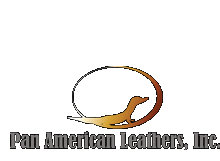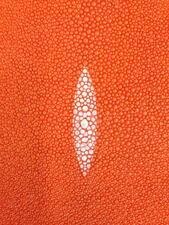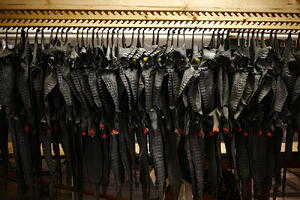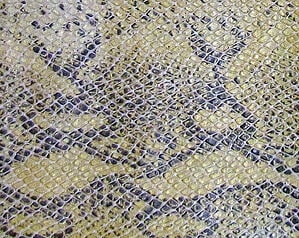 Using exotic leather materials in your designs, such as alligator skin, python skin and stingray skin can add endless amounts of personality to your work and create something that is truly one-of-a-kind. Beyond that, exotic leathers offer a whole new world of design opportunities to inspire you and impress clients.
Using exotic leather materials in your designs, such as alligator skin, python skin and stingray skin can add endless amounts of personality to your work and create something that is truly one-of-a-kind. Beyond that, exotic leathers offer a whole new world of design opportunities to inspire you and impress clients.
However, it is important to remember that not only are exotic leathers different from traditional cowhide leather visually, they each have special properties that need to be taken into consideration when crafting items from these beautiful materials. To help out, we’ve assembled a few tips and tricks for working with exotic leathers to make sure that your next design is perfect.
Tips for Stingray Skin
 Stingray leather is a very strong and durable material for crafting with. The tiny, pearl-like calcium deposits in the skin are attractive and create a strongly-textured appearance that can be used to great effect in your designs. Unlike cowhide, the fibers in the skin run in random directions and often crisscross with each other, making the skin very difficult to tear. In short, stingray leather is a very durable material.
Stingray leather is a very strong and durable material for crafting with. The tiny, pearl-like calcium deposits in the skin are attractive and create a strongly-textured appearance that can be used to great effect in your designs. Unlike cowhide, the fibers in the skin run in random directions and often crisscross with each other, making the skin very difficult to tear. In short, stingray leather is a very durable material.
While the durability of stingray skin means that the final product that is made from it will be durable and long-lasting, this very toughness can frustrate craftsmen who are not experienced in handling this material. We have heard many stories of first-time handlers bending or breaking sewing machines, needles, dies and blades on stingray skin. Yet, this is a situation that is very avoidable, and no, you don’t have to splurge on diamond-tipped needles.
With stingray, a little preparation goes a long way. You can use a dremel on the areas you intend to sew to smooth them out, creating a stitching line to reduce the chances of your sewing machine’s needle hitting a hard calcium pearl.
The toughness and damage resistance of stingray hide makes the ideal material for a leather surface that will see a lot of abuse, such as a custom leather tabletop. The calcium deposits in a stingray skin make it incredibly scratch resistant, and as an aquatic hide, the skin is naturally resistant to moisture, meaning that it can take the occasional drink spill like a champ.
When designing around the use of a stingray skin, remember that skins larger than 13” wide are hard to come by, and as such can be pricey. Rather than making large panels from a single skin, try buying several smaller skins to fill out your larger panels.
Tips for Alligator Skin
 Alligator skin is a wonderful material that is surprisingly versatile. The common misconception with alligator hide is that their skins would be too hard and rigid to work with, since the animals are famous for their toughness. However, first-time users of a properly-tanned alligator skin find these leathers to be surprisingly soft and supple. This is largely because the skin of the American alligator is less bony than the skins of other crocodile species.
Alligator skin is a wonderful material that is surprisingly versatile. The common misconception with alligator hide is that their skins would be too hard and rigid to work with, since the animals are famous for their toughness. However, first-time users of a properly-tanned alligator skin find these leathers to be surprisingly soft and supple. This is largely because the skin of the American alligator is less bony than the skins of other crocodile species.
Alligator skin is a great exotic leather for large furniture pieces that involve cushions, such as sofas, chairs, or even bedding. Use the belly for the large square panels and the tail for the longer panels. The square tile shapes on the scales of the belly and the longer rectangular tile shape on the scales of the tail compliment these placements well. Then you can use the head to for small accents and trim.
Tips for Python Hides
 Python skin is a very interesting material when it comes to making interior designs stand out. The skin of a python is very textured and scaly in appearance, making it very recognizable and distinctive.
Python skin is a very interesting material when it comes to making interior designs stand out. The skin of a python is very textured and scaly in appearance, making it very recognizable and distinctive.
However, you don’t have to use the natural patterns of a python’s skin, you can always get the markings of the python bleached and recolored to match your needs so that the final design can mesh without you having to completely rework your original color scheme around the python’s scale pattern (although that can produce some really jaw-dropping designs).
These skins tend to be long and narrow. However, with bleached python skin, you can easily work multiple hides together into a single piece for projects that require multiple skins in a single panel because of their width.
Also, with python skin, you can get either a back-cut or a front-cut, depending on whether you want to emphasize wide scales or the natural markings of the python’s back at the center of the panel.
Some Helpful Advice for All Types of Skins
While the toughness, flexibility, and patterns on each type of exotic leather will vary greatly, there are a few helpful tips that can be useful for most any exotic leather purchase:
- If your project requires large panels, consider if you’ll be better off purchasing a single, large grade 1 skin for each panel, or if several smaller skins would work. If money’s no object and the client requires as few seams as possible, the larger skins are definitely a good thing. However, clever work in designing the look of your project to work with panels that use multiple skins can make your piece truly unique.
- For really small panels, consider purchasing larger grade 2 skins and working around flaws or defects. Are you crafting a tiny, 3” jewelry box to sit atop a dresser? Double-check the prices of small grade 1 skins and larger grade 2 skins when ordering, you may be able to get multiple panels for small objects out of the larger skin for less total cost.
- Consider the size of your order when choosing to order from a tannery or a distributor. If your order is very small, a tannery will attach a surcharge to your order to cover their setup costs. A very large order, on the other hand, may end up costing more from a distributor than a tannery (because of the distributor’s mark-up).
No matter what exotic leather you use, it never hurts to make sure that you get the most out of your exotic leather purchase by discussing your project with an expert in the use of exotic leathers before you place your order.



